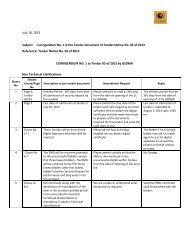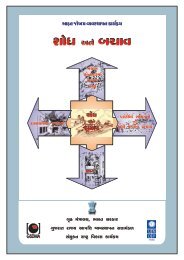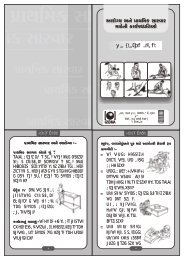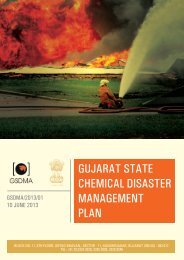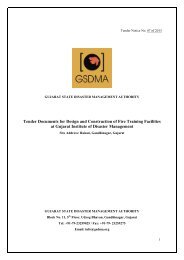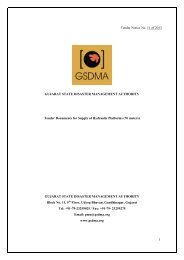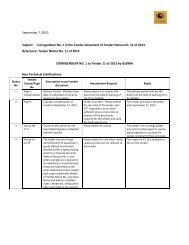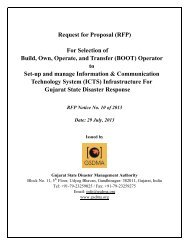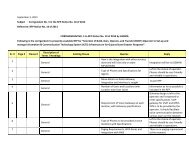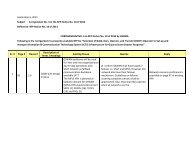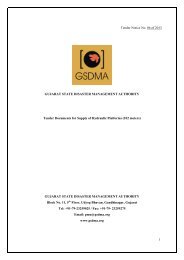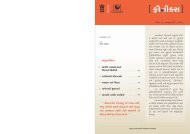Emergency Response Guidebook - Gujarat State Disaster ...
Emergency Response Guidebook - Gujarat State Disaster ...
Emergency Response Guidebook - Gujarat State Disaster ...
Create successful ePaper yourself
Turn your PDF publications into a flip-book with our unique Google optimized e-Paper software.
GUIDE118Gases - Flammable - CorrosiveERG2012ERG2012Gases - Flammable - CorrosiveGUIDE118POTENTIAL HAZARDSFIRE OR EXPLOSION• EXTREMELY FLAMMABLE.• May be ignited by heat, sparks or flames.• May form explosive mixtures with air.• Vapours from liquefied gas are initially heavier than air and spread along ground.• Vapours may travel to source of ignition and flash back.• Some of these materials may react violently with water.• Cylinders exposed to fire may vent and release flammable gas through pressure relief devices.• Containers may explode when heated.• Ruptured cylinders may rocket.HEALTH• May cause toxic effects if inhaled.• Vapours are extremely irritating.• Contact with gas or liquefied gas may cause burns, severe injury and/or frostbite.• Fire will produce irritating, corrosive and/or toxic gases.• Runoff from fire control may cause pollution.PUBLIC SAFETY• CALL EMERGENCY RESPONSE Telephone Number on Shipping Paper first. If Shipping Paper notavailable or no answer, refer to appropriate telephone number listed on the inside back cover.• As an immediate precautionary measure, isolate spill or leak area for at least 100 meters (330 feet) inall directions.• Keep unauthorized personnel away.• Stay upwind.• Many gases are heavier than air and will spread along ground and collect in low or confined areas(sewers, basements, tanks).• Keep out of low areas.• Ventilate closed spaces before entering.PROTECTIVE CLOTHING• Wear positive pressure self-contained breathing apparatus (SCBA).• Wear chemical protective clothing that is specifically recommended by the manufacturer. It mayprovide little or no thermal protection.• Structural firefighters' protective clothing provides limited protection in fire situations ONLY; it is noteffective in spill situations where direct contact with the substance is possible.EVACUATIONLarge Spill• Consider initial downwind evacuation for at least 800 meters (1/2 mile).Fire• If tank, rail car or tank truck is involved in a fire, ISOLATE for 1600 meters (1 mile) in all directions;also, consider initial evacuation for 1600 meters (1 mile) in all directions.EMERGENCY RESPONSEFIRE• DO NOT EXTINGUISH A LEAKING GAS FIRE UNLESS LEAK CAN BE STOPPED.Small Fire• Dry chemical or CO 2.Large Fire• Water spray, fog or regular foam.• Move containers from fire area if you can do it without risk.• Damaged cylinders should be handled only by specialists.Fire involving Tanks• Fight fire from maximum distance or use unmanned hose holders or monitor nozzles.• Cool containers with flooding quantities of water until well after fire is out.• Do not direct water at source of leak or safety devices; icing may occur.• Withdraw immediately in case of rising sound from venting safety devices or discoloration of tank.• ALWAYS stay away from tanks engulfed in fire.SPILL OR LEAK• ELIMINATE all ignition sources (no smoking, flares, sparks or flames in immediate area).• All equipment used when handling the product must be grounded.• Fully encapsulating, Vapour protective clothing should be worn for spills and leaks with no fire.• Do not touch or walk through spilled material.• Stop leak if you can do it without risk.• If possible, turn leaking containers so that gas escapes rather than liquid.• Use water spray to reduce Vapours or divert Vapour cloud drift. Avoid allowing water runoff tocontact spilled material.• Do not direct water at spill or source of leak.• Isolate area until gas has dispersed.FIRST AID• Move victim to fresh air.• Call 108 or emergency medical service.• Give artificial respiration if victim is not breathing.• Do not use mouth-to-mouth method if victim ingested or inhaled the substance; give artificialrespiration with the aid of a pocket mask equipped with a one-way valve or other properrespiratory medical device.• Administer oxygen if breathing is difficult.• Remove and isolate contaminated clothing and shoes.• In case of contact with liquefied gas, thaw frosted parts with lukewarm water.• In case of burns, immediately cool affected skin for as long as possible with cold water. Do notremove clothing if adhering to skin.• Keep victim warm and quiet.• Keep victim under observation.• Effects of contact or inhalation may be delayed.• Ensure that medical personnel are aware of the material(s) involved and take precautions to protectthemselves.Page 176Page 177



